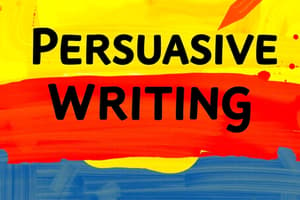Podcast
Questions and Answers
What is the primary purpose of an informative essay?
What is the primary purpose of an informative essay?
- To express personal opinions
- To entertain the reader
- To share information about a topic (correct)
- To convince the reader of a specific argument
How is the structure of an informative essay generally divided?
How is the structure of an informative essay generally divided?
- Introduction, body, and conclusion (correct)
- Introduction, body, and summary
- Overview, body, and conclusion
- Introduction, arguments, and conclusion
What should be included in the introduction section of an outline for an informative essay?
What should be included in the introduction section of an outline for an informative essay?
- Summary of body paragraphs and conclusion
- Counterarguments and conclusions
- Thesis statement and background information (correct)
- Supporting details and examples
How many body paragraphs does an informative essay typically include at a minimum?
How many body paragraphs does an informative essay typically include at a minimum?
When creating an outline, what designation is used for the body section?
When creating an outline, what designation is used for the body section?
What is the primary function of the thesis statement in an informative essay?
What is the primary function of the thesis statement in an informative essay?
Which component is NOT typically included in the body paragraphs of an informative essay?
Which component is NOT typically included in the body paragraphs of an informative essay?
What should a writer focus on when choosing a topic for an informative essay?
What should a writer focus on when choosing a topic for an informative essay?
How should writers approach the organization of their research for an informative essay?
How should writers approach the organization of their research for an informative essay?
What is a key step to take during the revising phase of the writing process?
What is a key step to take during the revising phase of the writing process?
What element might be included in the conclusion of an informative essay?
What element might be included in the conclusion of an informative essay?
What should be included in a rough thesis statement draft?
What should be included in a rough thesis statement draft?
What is a purpose of utilizing the 'hook' in an informative essay introduction?
What is a purpose of utilizing the 'hook' in an informative essay introduction?
Which of the following describes what a topic sentence does in a body paragraph?
Which of the following describes what a topic sentence does in a body paragraph?
Which phase follows the drafting process in writing an informative essay?
Which phase follows the drafting process in writing an informative essay?
Flashcards
Informative Essay
Informative Essay
A type of writing that gives information about a topic.
Informative Essay Outline
Informative Essay Outline
A plan to organize information for an informative essay, typically with introduction, body, and conclusion sections.
Essay Introduction
Essay Introduction
The first part of an essay, including a hook, background info, and a thesis statement.
Essay Body
Essay Body
Signup and view all the flashcards
Essay Outline Structure
Essay Outline Structure
Signup and view all the flashcards
Informative Essay Thesis
Informative Essay Thesis
Signup and view all the flashcards
Informative Essay Hook
Informative Essay Hook
Signup and view all the flashcards
Body Paragraph Organization
Body Paragraph Organization
Signup and view all the flashcards
Topic Sentence Role
Topic Sentence Role
Signup and view all the flashcards
Research and Sources
Research and Sources
Signup and view all the flashcards
Informative Essay Conclusion
Informative Essay Conclusion
Signup and view all the flashcards
Informative Essay Purpose
Informative Essay Purpose
Signup and view all the flashcards
Research Question Generation
Research Question Generation
Signup and view all the flashcards
Organizing Research by Color
Organizing Research by Color
Signup and view all the flashcards
Thesis as a Guide
Thesis as a Guide
Signup and view all the flashcards
Study Notes
Informative Essay Characteristics
- Informative essays aim to share information about a topic, unlike narrative essays (for entertainment) or argumentative essays (to convince).
- The structure typically includes an introduction, body, and conclusion.
- The introduction and conclusion are usually single paragraphs.
- The body section comprises several paragraphs (at least three).
Essay Outline and Structure
- Outlining is crucial for coherent writing, like blueprints in architecture.
- Outlines use Roman numerals (I. Introduction, II. Body, III. Conclusion).
- Subsequent levels use capital letters (A, B, C) and numbers (1, 2, 3).
- Outlines can be sentence-based or simply list topics.
- Consult your teacher for expected outline format.
Introduction
- Introductions start with a hook (engaging opening) to draw the reader in.
- Then, include background information relevant to the topic.
- A concise thesis statement summarizes the essay's focus; typically 1-2 sentences.
Body Paragraphs
- Each body paragraph supports the thesis.
- Start with a topic sentence (main idea).
- Include research (cited or paraphrased).
- Elaborate on the research; explain the evidence in detail.
- Avoid needless repetition of source material.
Conclusion
- Conclusions summarize the essay.
- Often restate the thesis in a different way.
- May include a call to action, encouraging further research/learning.
Writing an Informative Essay
- Topic Selection: Choose a topic for which you can conduct in-depth research; usually should be of interest to the student/writer.
- Research: Form questions to guide research, draw from prior knowledge. Organize research (color-coding, notecards) to correspond with the questions asked.
- Paragraph Organization: Identify topic sentences, then support with researched information, explained in detail.
- Essay Drafting: Start with a draft thesis statement (lead + transition + focus).
- Revision and Editing:
- Ensure each paragraph supports the thesis statement.
- Evaluate paragraph order.
- Proofread for grammar, spelling, and punctuation errors (editing).
- Get feedback from others.
Example Essay Elements
- Introduction Example: Sensory hook; background information about a topic; thesis statement defining the essay's specific focus.
- Body Paragraph Example: Specific topic of celebration; supporting research and details; explanation of significance.
- Conclusion Example: Restated thesis in a fresh manner; call to action for additional exploration.
Studying That Suits You
Use AI to generate personalized quizzes and flashcards to suit your learning preferences.




